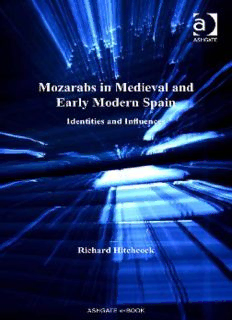
Mozarabs in Medieval and Early Modern Spain PDF
Preview Mozarabs in Medieval and Early Modern Spain
MOZARABS IN MEDIEVAL AND EARLY MODERN SPAIN For Molly, Clem and Grace, and above all, for Meg Mozarabs in Medieval and Early Modern Spain Identities and Influences RICHARD HITCHCOCK University of Exeter, UK © Richard Hitchcock 2008 All rights reserved. No part of this publication may be reproduced, stored in a retrieval system or transmitted in any form or by any means, electronic, mechanical, photocopying, recording or otherwise without the prior permission of the publisher. Richard Hitchcock has asserted his moral right under the Copyright, Designs and Patents Act, 1988, to be identified as the author of this work. Published by Ashgate Publishing Limited Ashgate Publishing Company Gower House Suite 420 Croft Road 101 Cherry Street Aldershot Burlington, VT 05401–4405 Hampshire GU11 3HR USA England Ashgate website: http://www.ashgate.com British Library Cataloguing in Publication Data Hitchcock, Richard Mozarabs in medieval and early modern Spain : identities and influences 1. Mozarabs 2. Mozarabs – Spain –Andalusia 3. Christianity and other religions – Spain – History – To 1500 4. Islam – Spain – Relations – Christianity 5. Spain – Religious life and customs 6. Spain – History – 711–1516 I. Title 274.6’03 ISBN 978–0–7546–6314–0 Library of Congress Cataloging-in-Publication Data Hitchcock, Richard. Mozarabs in medieval and early modern Spain : identities and influences / Richard Hitchcock. p. cm. Includes bibliographical references. ISBN 978–0-7546–6314–0 (alk. paper) 1. Mozarabs. 2. Christians – Spain. 3. Spain – Church history. I. Title. BR1024.H58 2007 305.9’27009460902–dc22 2007023181 Printed and bound in Great Britain by TJ International Ltd, Padstow, Cornwall Contents Introduction: The Terminological Question ix 1 Meaning and Origins 1 2 Muslims and Christians in al-Andalus in the Early Eighth Century 7 3 The Case of Córdoba in the Ninth Century 25 4 Christians in Córdoba 41 5 Mozarabism in León I: Arabic Nomenclature 53 6 Mozarabism in León II: Mozarabs 69 7 Mozarabs in Toledo 75 8 Mozarabs in Aragón 99 9 Mozarabs after 1492 109 Postscript 129 Bibliography 131 Index 147 Map 1 The territory of al-Andalus in the tenth century Map 2 Mozarabic churches and others in the north-west of the Iberian Peninsula in the tenth century This page intentionally left blank Introduction The Terminological Question When my late friend and colleague M.A. Shaban embarked on the long and arduous journey into the origins of the Islamic revolution, he made the following observation about his own modus operandi: ‘Considerable care has been taken to ascertain the exact meaning and to define the precise use of important terms used by the compilers of the sources and the authorities they quote.’1 Later on he elaborated on this: ‘The meaning of such terms varied from place to place and often enough changed over the centuries, and it is of vital importance to examine systematically these changes in order to obtain proper understanding of the source material.’2 One such ‘important term’ is the subject of this book, and the warnings voiced by Shaban have been taken to heart. The interpretation that is presented for the word ‘Mozarab’ is one that is believed to fit the variegated data afforded by sources, which themselves can only considered to be exceptionally heterogeneous.3 The origin of the word ‘Mozarab’ is musta‛rib, active participle, or musta‛rab, passive participle of the tenth derived form of the Arabic root ‛araba, meaning in the active sense, ‘to make oneself similar to the Arabs’, and in the passive, ‘having assimilated Arabic customs’, or, most specifically designating someone who had the appearance of an Arab, was indistinguishable from Arabs, and would not stand out in a crowd of Arabs.4 Phonetically, the passive participle would appear to be the more probable etymon, in view of the post-tonic ‘a’, and this supposition is supported by entries in early vocabularies.5 Arabic dictionaries are unanimous 1 M.A. Shaban, Islamic History AD 600–750 (AH 132). A New Interpretation, Cambridge: University Press, 1971, p. viii. 2 M.A. Shaban, Islamic History. A New Interpretation. 2. AD 750–1055 (AH 132–448), Cambridge: University Press, 1976, p. ix. 3 The nature of these sources has been subject to much revision and scrutiny over the past thirty years. See the article by Norman Daniel, published posthumously: ‘Spanish Christian Sources of Information about Islam (ninth–thirteenth centuries)’, al-Qanṭara, XV (1994), 366–84; P.S. Van Koningsveld, ‘Christian-Arabic Manuscripts from the Iberian Peninsula and North Africa: A Historical Interpretation’, al-Qanṭara, XV (1994), 423–51; Actas del I Congreso Nacional de Cultura Mozárabe,Córdoba, 27–30 April 1995, Córdoba: Cajasur, 1996. 4 Juan Corominas, Diccionario crítico etimológico de la lengua castellana, Berne: Francke, 1954, I, p. 244b. 5 Pedro de Alcalá, Vocabulista aravigo en letra castellana,Granada, 1505, ed. Pauli Lagarde, Gottingae: Arnold Hoyer, 1883: ‘Arabigo Musta’arabi’ (p. 103, line 23), unpaginated MS in the Biblioteca Nacional, Madrid, (R2209), and Federico Corriente, El Léxico árabe andalusí según P. de Alcalá,Madrid: Universidad Complutense, 1988, p. 134; Vocabulista in Arabico, ed. C.
Description: